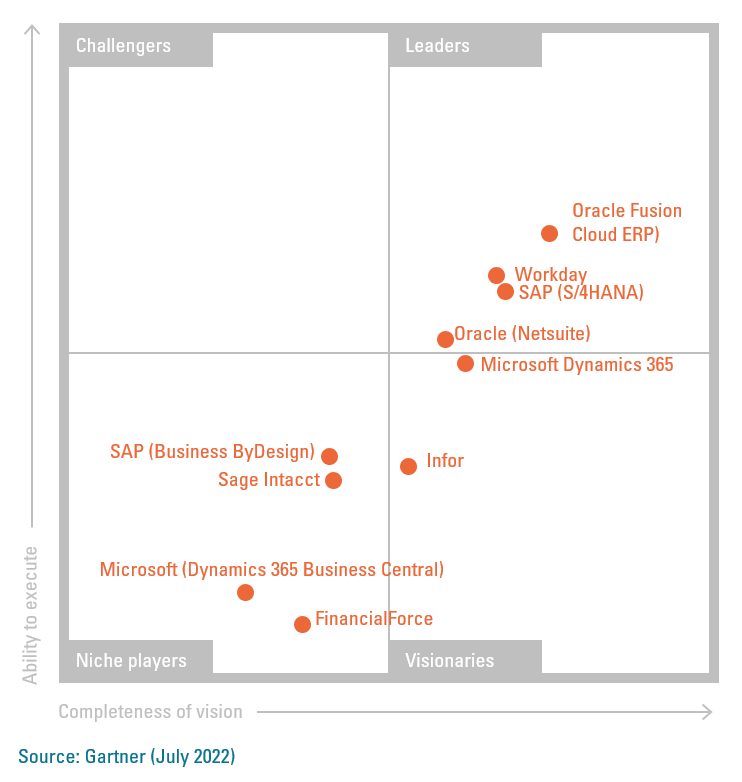
What's new in the Magic Quadrant Cloud ERP for Service Centric Enterprises?
In July 2022, Gartner published the Magic Quadrant for Cloud ERP for Service-Centric Enterprises. This new Magic Quadrant focuses entirely on ERP for service organizations. Enterprises can increasingly be characterized as a service provider. This Magic Quadrant is therefore relevant to many enterprises. We summarized the main conclusions of the 26 page report for you.
What is a Cloud ERP for Service Centric Enterprises solution?
Firstly, a Cloud ERP for Service-Centric Enterprises supports the processes of a service organization. On top of that, a Cloud ERP for Service Centric Enterprises provides functionality for financial management, human resource management, order-to-cash, procure to pay and professional service automation, among others. These types of solutions are typically found in professional services organizations but also in industries such as media, telecom and financial services.
In addition to this Magic Quadrant for service providers, Gartner also publishes a Magic Quadrant for so-called Product-Centric Enterprises. These are organizations that produce, sell and/or distribute physical products. We will discuss this Product-Centric Magic Quadrant in this blog.
Which solutions are included in this Magic Quadrant?
Ten solutions are included in this edition of this Magic Quadrant. In order to be included, a solution must meet these three criteria:
- The solution must offer all product capabilities defined by Gartner for this category (think: human capital management, financial management).
- The solution must be used by at least 150 substantial organizations in
- The solution must truly be offered as a cloud service.
Major vendors such as Microsoft, Oracle and SAP are included with more than one solution. Most of the time, this means that there is a true mid-market solution and a solution for large/complex organizations available. The graphical representation of Gartner’s quadrant is shown below.

More and more focus on “composable architectures”
Gartner’s research shows that more and more organizations are leaning toward so-called “composable architectures”. In a composable architecture, an organization chooses to have a number of applications connected to each other rather than one large integrated system. Even organizations that initially want to opt for a single integrated system eventually make the choice for such a composable architecture. Gartner expects that by 2027, 80% of companies will consider using a composable architecture. Organizations should therefore at least keep the idea of composable architecture in the back of their mind when making decisions.
Finance-First for success
According to Gartner’s survey, moving to a cloud ERP solution does not always go without a hitch. The implementation of finance components proves to be difficult in particular. Resistance to change is typically high in this target group. Extra effort in change management is therefore necessary. Because implementations in the finance domain are often complex due to regulations, among other things, a finance-first approach is often chosen. Afterwards, areas such as human resources and procurement are addressed.
Integration is key
The success of a new cloud ERP system depends largely on its ability to integrate with existing on-premise and cloud applications. Proper consideration of the right integration strategy is crucial here. Sometimes this requires new skills within the IT organization in addition to the new cloud ERP.
Service-centric Enterprises lead the way
Cloud technology adoption is higher among service-centric enterprises than among product-centric enterprises. This seems to be due to less complex order-to-cash processes, among other things. Gartner expects that 70% of the growth in cloud ERP solutions will come from service-centric enterprises in the coming years.
Want to know more?
Are you considering looking into a new ERP solution? Or would you like to explore the possibilities? Schedule an introductory meeting with us here or leave your details below and we will get back to you.
Thank you for your message!
We will get back to you as soon as possible.
Cases & Solutions

Three hidden secrets from Gartner’s Magic Quadrant for Enterprise Architecture tools
In late 2021, Gartner published its Magic Quadrant for Enterprise Architecture Tools. It lists the highest-performing vendors with focus and momentum in the market for EA tools. Although the market for Enterprise Architecture tools is still young and in full development the report is a great resource. But not many take the time to look beyond the famous two-by-two-matrix. Luckily for you, we did read the entire report and we found three key takeaways that you would miss out on if you just focus on the quadrant.

Software selection in practice: A future proof system for Luminis
Luminis is a fast-growing software and technology company with multiple branches in the Netherlands and the UK. Luminis’ services are on the cutting edge of technology, specializing in offering cloud services through developing its products and consulting. However, the technology that is used internally is not optimized, and much time is spent on manual tasks. We spoke with Laurens Miedema, CFO of Luminis, regarding the choice of moving from Exact to Microsoft Business Central.